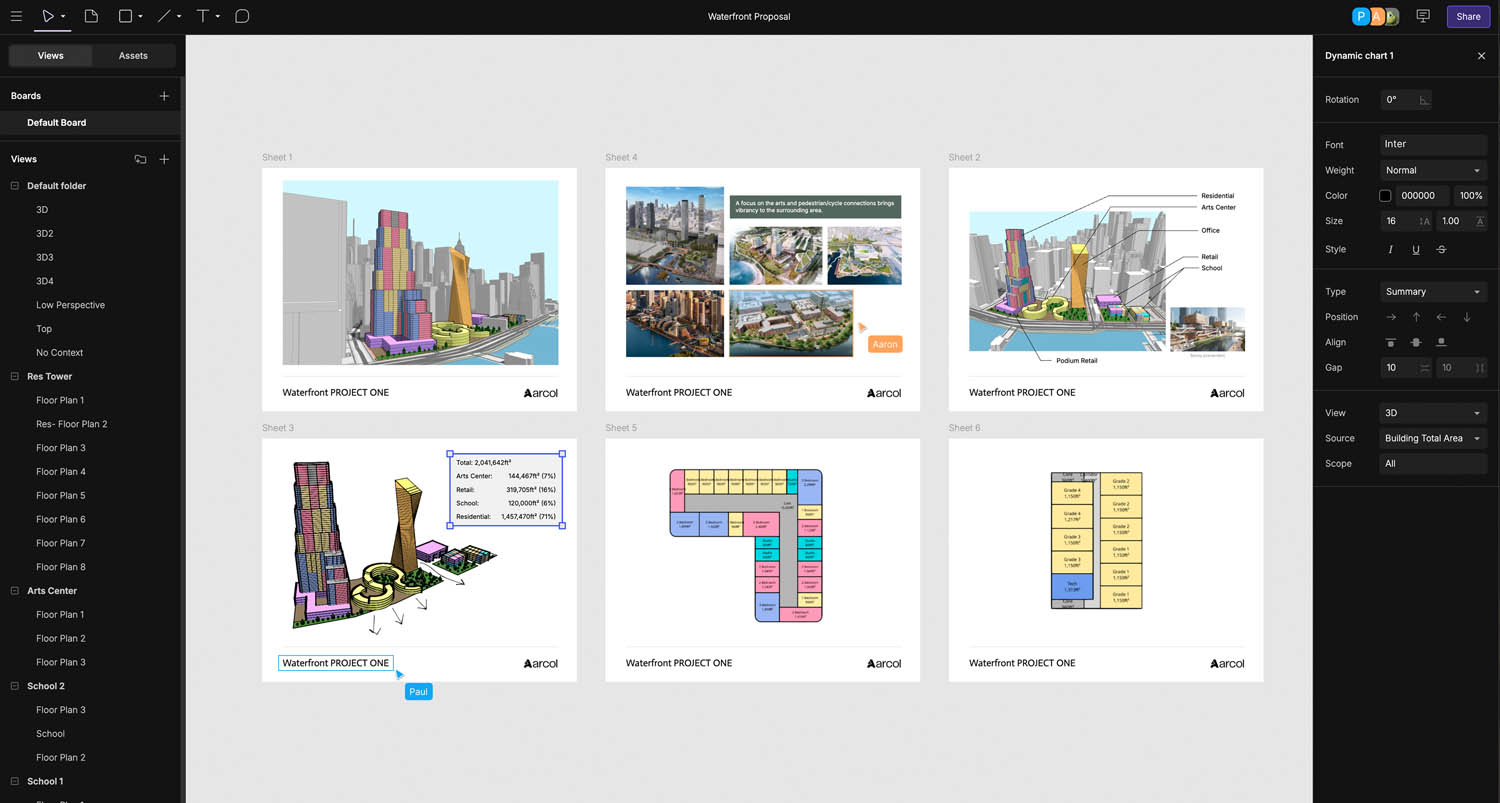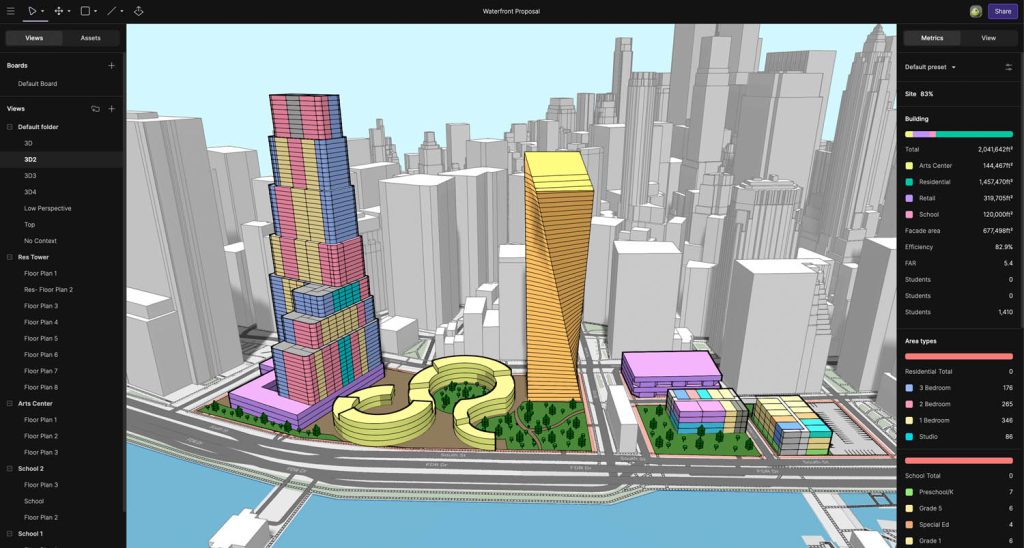BIM 2.0 start-up Arcol officially launched its product at the start of June and presented at our recent NXT BLD conference. With an initial focus on providing a browser-based environment for collaborative conceptual design, the software is already attracting a growing fan base
While the idea of BIM 2.0 is exciting, there is a lot of confusion among BIM users as to how new code streams should manifest themselves. If the intention is to compete against Revit, then surely rivals should resemble Revit in terms of user experience and offer comparable features?
Not necessarily. Revit, after all, is 25 years old. It covers a wide range of design phases, including concept, detail design, rendering and documentation/ drawings. It also provides tools for multiple disciplines, such as MEP and structural engineering.
In contrast, the BIM 2.0 software developers are all opting to drop in and develop products at different points along the design phase. Their aim is to provide something useful, quickly, and then grow out their applications over time, adding breadth and depth to the tools along the way.
Find this article plus many more in the July / August 2025 Edition of AEC Magazine
👉 Subscribe FREE here 👈
Take, for example, Arcol: the leadership team at this start-up has chosen to start specifically at the conceptual phase. That makes sense, since it’s the start of the AEC process.
However, this is also an extremely busy segment of the market, boasting many established players as well as so many start-ups that we have lost count.
Obviously, the 800lb gorillas of this segment are SketchUp and, at the highend, McNeel Rhino with Grasshopper. But then we also have Autodesk Forma, which is essentially ‘given away’ as part of the company’s AEC Collection.
Simply put, customers are not short of options and some capabilities are already offered in the boxes of tools for which they’ve already paid. In software terms, this is a tough neighbourhood. Any start-up that wants to elbow in needs to be able to offer a product sufficiently compelling for its buzz to be heard above the general noise.
Origin story
Arcol was the original ‘Figma for BIM’ protagonist. Its founder and CEO Paul O’Carroll was already a huge Figma fan and recognised how it was possible to make a generic web-based, collaborative interface design tool. His father, meanwhile, is an architect, so he has always been attracted to the industry and understands its frustration with the lack of innovation and collaboration in the current generation of BIM tools.
With a background in games development and experience of running a design agency that built custom tools for clients, O’Carroll felt these were challenges he could tackle. In 2021, he founded Arcol in order to build a 3D, sketch-based, collaborative design tool. He quickly raised seed money from a cast of industry notables. These include Craig ‘Tooey’ Courtemanche, founder of Procore, and Amar Hanspal, ex-joint CEO of Autodesk and now CEO at competitor Motif (but that’s another story), along with some core Figma alumni and VC firms. With that funding tied down, O’Carroll moved from Ireland to New York and started building out Arcol’s young team.
Four years later, having taken a cautious approach to publicly showing exactly what Arcol was developing, O’Carroll deemed that the product had enough features to address key pain points and was ready to charge for subscription.
Prior to its June 2025 launch, Arcol opened up the product for a free trial for one week last year. Most of the beta testing, however, was conducted with trusted architectural firms. In late 2024, the company attracted a further round of VC funding, of an undisclosed amount, on top of its original seed funding of $5 million.
Arcol presented at NXT BLD this year and has been actively hiring all summer. Its plan now is to build on its newly commercialised code base and start expanding its concept capabilities, as well as begin to address more complex modelling centric issues.

Core capabilities
Arcol is a next-generation, cloud-native BIM 2.0 modelling system for architects. As it’s all web-based, it eliminates the need for downloads, installations or specific client operating systems. But being web-based doesn’t mean it’s slow. In fact, it’s remarkably zippy on large context models (although the level of detail it currently supports is not complex geometry).
As mentioned, Arcol primarily focuses on pre-design and early-stage design and offers real-time, multi-user collaboration, complex modelling and seamless data integration, along with integrated presentation tools – and all within a web-based environment. A single version of the truth is shared and collaborated in real time between teams. The user interface is fresh, simple to navigate and easy to use, with a very low barrier to entry and gentle learning curve.
For now, the capabilities of Arcol break down to Boards, Modelling, Metrics and Collaboration. In some ways, Arcol is a combination of SketchUp, TestFit, Miro, InDesign, Slack, and Figma, all in one package. Concepts can be modelled in context. Building metrics can be derived from multiple complex design decisions made by teams and then used to develop presentations that can be shared internally or to clients to sell architectural designs.
Support for more complex detailed modelling is under development. Deep integration with Rhino and Grasshopper is also in the works, with Arcol working closely with McNeel, according to O’Carroll
First, let’s take a look at Boards. From very early on, O’Carroll wanted to address the architect’s need for presentation tools. While lockdown saw the growth of Miro and Mural, Arcol was the first BIM 2.0 tool to recognise that AEC-specific mood board creation and presentations should be a core function. That’s a capability that we have since seen copied by Motif and Snaptrude in their applications.
Arcol boards are ‘live-synced’ and presentation layouts automatically update as the building changes. These boards can include 3D model views, design-related data, mood images and external content such as client project briefs. Sharing of boards is performed via a web link and users don’t need a paid licence for Arcol if they’re just there for viewing purposes. Arcol wants to replace static PDF exports.
Another key capability is Arcol’s presentation to users of a single version of truth. Being cloud-based, data is centralised and shared amongst collaborators. Only one version of the model and its related data exists, so users don’t have to worry about multiple files or navigating a revision management system. Every user, in every browser, gets access to the same data. It’s always consistent.
This also extends to the comments capability. In order to keep communication connected to a design, Arcol has a built-in commenting system, linked to dropped bubbles in the design space, so that teammates can add their input to designs. Clicking on a bubble brings up complete related threads in the sidebar. When problems are resolved, users hit the check mark and the comment gets hidden.
At NXT BLD, the team gave a demonstration that involved one user in the UK modelling the bottom half of a building, while a colleague in New York modelled the top half. This was all done in the same session, using the same drafting tools. Meanwhile, a third user was working on the presentation layout of the yet-to-be-completed building – all in one continuous stream of collaborative work.
Modelling and metrics
Modelling in Arcol is deceptively easy. Deceptive, because under the surface, there’s a lot of complexity being masked from the user. Each modelling operation exists in a live, editable history graph, so users can adjust past steps at any time and the model regenerates. Due to the constraints of working in-browser, this must be done quickly and with memory efficiency.
Arcol can be used to create lofts, push/ pull edits, sweeps, extrudes and Booleans. It supports custom drawing planes and parametrics and comes with a range of architectural primitive elements, covering all the basics.
Masses can be divided into floors, to generate plans that then feed into the metric calculations engine, providing information on areas, costs and parking needs, for example. Materials can be added and shadow studies created.
Site context and DWGs can be imported to anchor an Arcol model. These Arcol mass designs can be exported to Revit, which brings the geometry in as native Revit masses. At this moment in time, Arcol’s role is preRevit detail design, and is therefore competitive to massing in Revit, Forma or SketchUp. It’s also possible to export GLTF for game engines and arch viz tools.
In terms of metrics, Arcol currently offers the following analyses: Site Zoning, Floor & Building, Cost Estimation and Shadow Studies. It connects the results with any live associated documents, updating not just related presentation board layouts and the physical model in a board view, but also any related text, such as area and cost.
In its right-hand panel, Arcol displays any relevant building metric data, supporting a range of building, site, environment and cost metrics. For building information, it calculates total floor area, number of floors, floor area ratio, gross internal area, unit count and floor height. For site information, Arcol calculates site area, percentage coverage, setbacks, landuse allocation and parking counts. Costwise, the software performs construction cost estimates, cost per unit or per floor, and envelope area.
To generate a shadow study, the user simply enters a project’s geolocation, date and time. Again, using the boards function, multiple sun studies can be compared. The team can’t be far off delivering daylight studies, as the reverse of this.
Pricing and future plans
As with most software today, Arcol is offered on a subscription basis. There is a free version available for solo users, although this comes with some omissions, such as Revit Export, and some limitations, in terms of project numbers. A Team subscription costs $100 per user, per month, with a few extra perks for subscribers who pay annually. There are ‘editor’ seats for those who design, and ‘collaborator’ seats for those who only need to view and comment on designs. While editors need a licence, collaborators (such as clients or contractors) do not and simply get access via a shared link.
It’s worth noting that, at present, Arcol doesn’t support Apple Safari and recommends Google Chrome or Microsoft Edge.
What strikes us about Arcol is that O’Carroll’s vision hasn’t changed since the first day we spoke to him. The aim is to build on top of Arcol and eventually compete against Revit by offering everything from concept to detail design and on through to documentation.
While his team could take shortcuts and licence OEM technology in order to build out faster, O’Carroll has already got ideas as to how Arcol should implement features such as the creation of drawings. As such, he intends to chart his own path, relying on internal development effort, rather than bolting on third-party generic capabilities. He explains that he wants to build trust with customers in the early stages of design before tackling drawings.
Either way, Arcol looks set to carve its own niche in the AEC space. It is clearly currently a conceptual tool and blends a number of features to help solve a variety of competing design requirements, while also giving teams a new way to work together and create and present schemes to clients. There is an argument that Arcol could pay for itself by replacing a number of seats of various tools, such as Miro, SketchUp, and InDesign, although SketchUp is more of a design and drawing environment.
Arcol’s interface is sleek and its graphics really are eye-popping. While geometrically, models look fairly simple, it does offer parametrics, curves, push/pull and Booleans for massing. Support for more complex detailed modelling is under development. Deep integration with Rhino and Grasshopper is also in the works, with Arcol working closely with McNeel, according to O’Carroll. This will open up Arcol to more advanced architectural practices where Rhino is the core design environment.
While the obvious target market for Arcol is architects, O’Carroll tells us that he’s excited at the traction the company is achieving among contractors. Here, we guess, the company’s close links with Procore could be of serious benefit.
For developers, there are a range of feasibility tools that enable real-time costs to be displayed as a model is updated. This data is just as useful to architects as it approaches the floorplan level of detail. It’s obviously not as fully featured for site development as something like TestFit Site Solver, which costs $8k a year for a full seat, but I think the target markets are slightly different.
Since Arcol’s launch and its presentations at both the AIA annual conference and our own NXT BLD event, the company has received a lot of attention from investors and competitors.
By focusing on a very identifiable phase of the design process, the team has developed a product that is easy to compare and contrast with other well-known products. This is something that’s very hard to do with offerings from other BIM 2.0 startups such as Snaptrude, Motif, Hypar and Qonic.
The fact is that, by choosing to develop software that would compete in an overheated and over-serviced market where ‘freemium’ models are commonplace, O’Carroll took a big risk. In fact, we’d bet that he probably got bored of hearing that warning, over and over again.
But through a hefty dose of self-belief, a clear execution strategy, surviving the occasional shower of shit and a strong streak of bloody mindedness, Arcol has arrived. What’s been delivered is very impressive and strikingly close to what O’Carroll described to us at the company’s earliest stages. With new investment and new additions to the team, we expect to see the velocity of development accelerate sharply in months to come.
Recommended viewing
At AEC Magazine’s NXT BLD, Arcol’s Aaron Fife & Mike Buss demonstrated how the browser-based design tool can unify model, data, and presentations in a real-time, multiplayer environment using designers located in London and New York.
CLICK HERE to watch the whole presentation
Watch the teaser below
Main image: Arcol’s user interface is fresh, simple to navigate and easy to use, with a very low barrier to entry and a gentle learning curve.







